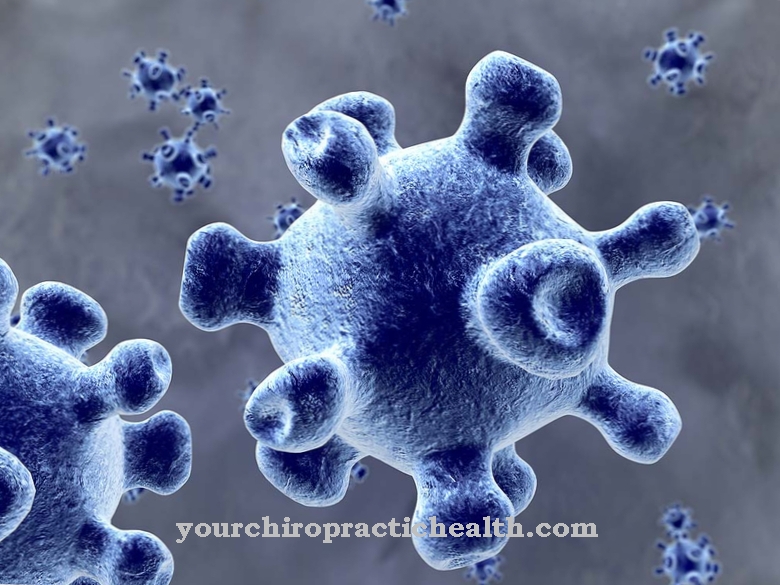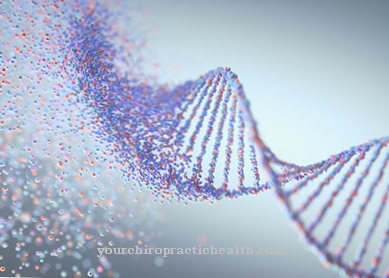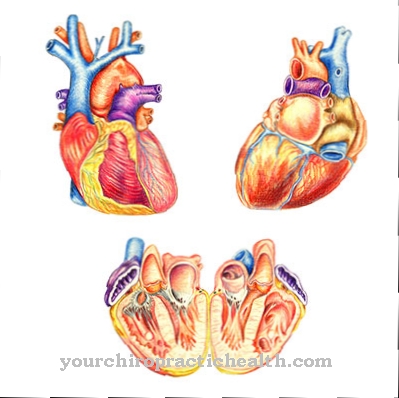The clinical picture of Sciatic pain, also known as sciatica or Sciatica is one of the most common diseases in developed industrial nations. Since the average duration of the illness of sciatica is often several weeks, its economic importance is enormous. The treatment options and prognosis for sciatic pain are good, however.
What does sciatica (sciatic pain) mean
.jpg)
Often also as Lumboischialgia denotes the cause of the sciatica in an irritation of the posterior nerve root of the sciatic nerve in the lower back.
Sciatic pain is therefore not a disease of the actual spinal cord, as is often and incorrectly assumed. The experienced, clinically active doctor can differentiate these symptoms of sciatica from the purely muscular back pain (so-called LBP, low back pain) by using careful examination techniques.
causes
Cause of said irritation of the sciatica are in over 90% of all cases age-related wear and tear of the associated bony vertebral elements, between which the nerves emerge. In rarer cases, however, the consequences of accidents, inflammation or even tumors can also be the causes of sciatic pain.
Symptoms, ailments & signs
When the sciatica is impaired, back pain at the level of the lumbar spine typically occurs. They pull from the lower back down over the back of the thigh to the hollow of the knee, sometimes even into the foot. The type of pain varies depending on the underlying cause. If the sciatic nerve is pinched by a herniated disc, the pain occurs suddenly and appears tearing or tearing.
It is often perceived as electrifying and is described by doctors as neuropathic. In contrast, when the nerve is stimulated, the pain develops gradually and is usually accompanied by muscle tension and restricted mobility. Typical of sciatica is that the pain becomes worse at night. If the nerve is already very damaged, it can also lead to sensory disturbances.
It usually begins with a tingling sensation that gradually turns into numbness and can even worsen to paralysis. Additionally, the patient may have difficulty standing on the toes or heels. Pain that is present may increase when you cough or sneeze. Clenching during bowel movements can also be painful. If the sciatic nerve is severely compromised, incontinence can occur in both the bladder and bowel.
Diagnosis & course
The often several weeks course of a Sciatica is characterized by pain that is often very severe (or even really unbearable), which, for example, may initially require the use of infusion treatments.
Initially, immobilization is indicated until the acute symptoms of the sciatic pain have subsided. Typical for sciatica is the spread of pain according to the so-called general stripe line. This is based on the gold border that may have adorned the side of a general's trousers in earlier times.
This stage of irritation of the sciatic nerve requires early and regular medical observation and follow-up, because it can sometimes lead to acute paralysis. The patient notices this on the shelf the fastest when climbing stairs only when the leg in question is no longer subject to his will.
Immediately, the greatest urgency is required and the neurosurgeon must surgically relieve the distressed sciatica so that the nerve pressure ceases and the paralysis does not last. Sciatica surgery should take place within a few hours of the onset of the symptoms of paralysis, otherwise the nerve tissue will be permanently damaged.
Complications
As a rule, the sciatic pain is very uncomfortable pain for the person affected. This mainly leads to pain in the back and spine. Back pain often spreads to other regions of the body and can lead to pain there too. Furthermore, pain at rest can lead to sleep problems and thus to irritability of the patient or to depression and other psychological upsets.
Many of those affected also suffer from paralysis or from sensory disorders. These can significantly limit the day-to-day life of the person affected and possibly also lead to restricted mobility. In extreme cases, patients are then dependent on the help of other people in their everyday life due to the sciatic pain. A herniated disc can also occur.
Sciatic pain is usually treated with the help of medication or various therapies. This can limit the pain. It cannot be generally predicted whether this will lead to a positive course of the disease. If necessary, the patient is then dependent on lifelong therapy. The life expectancy of the patient is usually not restricted by the sciatic pain.
When should you go to the doctor?
A doctor should be consulted in the event of back problems, severe pain or restricted mobility. If the symptoms set in unexpectedly and suddenly, the person affected can often no longer move as usual. If you experience numbness in your back, sensory disorders or hypersensitivity, a doctor's visit is necessary. In the event of signs of paralysis, limitations in physical resilience and changes in the usual range of motion, the symptoms should be clarified by a doctor. A loss of strength, sleep disturbances or a feeling of stiffness in the back should be examined and treated. If the daily requirements can no longer be met or if it is not possible to pursue the usual sporting activities, it is advisable to consult a doctor.
If you are unable to bend your back, stretch your back, stand up or walk without symptoms, you should consult a doctor as soon as possible. If movements can only be implemented very slowly, a doctor's visit is required. If the pain is of increasing intensity or if it continues to spread on the back, a doctor is required. Before taking a pain medication, it is advisable to consult a doctor to avoid undesirable consequences. If there are emotional or mental problems in addition to the physical complaints, further examinations and medical treatment are advisable. Otherwise, without medical care, the person concerned could face life-long impairments or mobility disorders.
Treatment & Therapy
Since numerous nerve cords cross each other and also separate again on their way to the muscles supplied with them in the legs and the buttocks muscles, it can happen with the Sciatica come to a complex, colorful and changeable clinical picture.
A thorough knowledge of anatomy and neurology is therefore required. The diagnosis should therefore be left to a doctor or specialist, ideally someone specializing in orthopedics, trauma surgery or neurology.
In addition to the necessary physical examination, people suffering from sciatic pain are usually also subjected to an imaging test. Without the use of X-rays, magnetic resonance imaging, also known as MRT technology, can be used to produce high-resolution images of the relevant body region, which then help to secure the diagnosis. In rare cases of sciatica, a puncture and / or more extensive laboratory diagnostics are required.
As a rule, however, sciatica heals with conservative medical treatment. In addition to the necessary pain reliever medication, this also includes the use of supportive, regularly performed physiotherapy applications and regular physiotherapy support. In sciatica, these therapies can, depending on the severity, be carried out on an inpatient basis, i.e. in an acute hospital, or, in less severe cases, on an outpatient basis.
You can find your medication here
➔ Medicines for back painOutlook & forecast
Sciatic pain has very different prognoses. In almost all those affected, they occur again and again, although they can become more common with age and depending on the cause.
Pain therapy of any kind can shorten the course of the disease and delay or prevent recurrence of sciatica problems. However, it can be assumed that several possible causes of sciatic pain (e.g. rheumatism and spinal problems) repeatedly lead to problems. Treating the cause can fix the problem, but it also carries a certain risk of relapse.
Those affected who want to reduce the likelihood of recurrence of sciatic pain are well advised to do muscle training. The better and stronger the muscles in the abdomen and back, the more stable the body is. Accordingly, there are fewer conditions that trigger sciatic pain. Accordingly, a back-friendly lifestyle for those affected is one of the measures to be taken.
Furthermore, the prognosis improves in a stress-free environment. Since sciatic pain often also comes to light as a result of psychological stress, those affected should make sure that stress is avoided after treatment. A longer period of recovery can strengthen the body further and make further problems with the sciatica less likely.
prevention
After several weeks it is at Sciatic pain the ability to work restored. In some cases, it is also advisable to recommend inpatient rehabilitation and to carry it out at the expense of the health insurance company or the pension insurance company.
In addition to the necessary medical treatment, an intensive transfer of knowledge to the patient is carried out there. This should lead to the patient taking his health into their own hands as far as possible through health-promoting behavior after his discharge, in order to avoid a recurrence of the sciatica.
This succeeds completely in a large number of cases. In other patients with sciatic pain, medication can often be reduced significantly.
Other preventive measures against sciatic pain are in principle similar to those for back pain and against herniated discs. That means sport and exercise as well as training of the back muscles. On the other hand, too heavy loads should be prevented from permanently damaging the back. Sitting for a long time or incorrectly sitting should also be avoided. Back exercises can be extremely beneficial in preventing sciatic pain.
Aftercare
Sciatic pain can often be treated well by self-help. In many cases, it depends on the patient's cooperation to alleviate the symptoms. Because the sciatica problem is often caused by poor posture or incorrect load, sometimes in connection with being overweight, so that it is up to the behavior of those affected to bring about an improvement.
In acute cases, the stepped positioning often helps. The patient lies with his back on a stable surface and places the lower legs on a chair or other elevation. The angles in the hip and knee joint are 90 percent. Warmth can also be helpful.
Muscular training is important for chronic sciatica problems. The muscles in the buttocks and the core muscles made up of the abdomen and back need to be strengthened. The muscles on the back of the thighs, which are often shortened, should be gently stretched.
Bad posture and excessive stress in everyday life and at work are to be avoided. In this context, breaks and relaxation during long car journeys are just as important as an ergonomic seat at the desk. Back exercises in the fitness studio stabilize the overall corset of the spine.
The exercises learned there can also be continued regularly at home. Backstroke and aqua aerobics are also often helpful. Relaxation processes and yoga help to improve or even eliminate tension in the muscles over the long term. Jacobsen's progressive muscle relaxation is particularly recommended.
You can do that yourself
In the case of acute sciatic pain, the so-called step position is recommended to relieve the spine: The patient lies flat on their back, the legs are raised at a 90-degree angle on a chair or pillow.
The application of heat is also helpful in relieving the tension in the lower back that is typical of sciatica. A hot water bottle or a cherry stone pillow serve well, a warm bath with soothing herbal additives such as hay flowers, rosemary or lavender also loosens the cramped muscles.
Tried and tested home remedies include compresses soaked in mustard or horseradish and compresses made from healing earth; alternatively, warming ointments are available from the pharmacy. Bed rest is recommended for a maximum of one to two days, after which light exercise should be started again. It is important to pay attention to the signals of the body and not to excessively or incorrectly strain the painful back.
If sciatic pain occurs again and again, strengthening the back muscles through targeted training can bring relief. Heavy lifting should be avoided and an ergonomic posture should be observed when working on the computer. Choosing the right mattress also helps avoid recurring sciatic pain: it should not be too soft and should be tailored to your body weight and size.


.jpg)

.jpg)



















.jpg)



